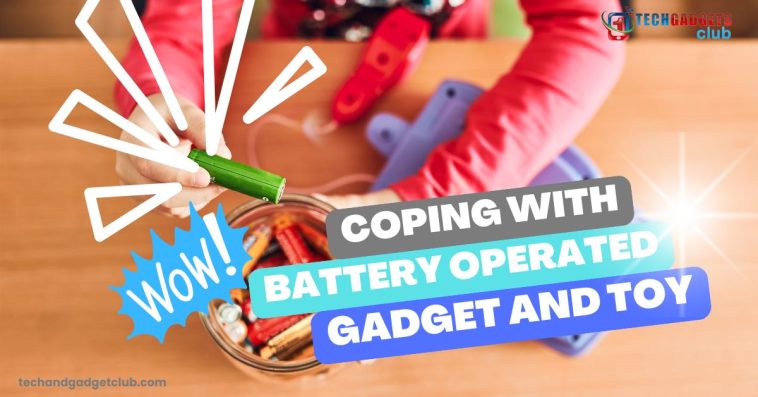Our homes are filled with children’s battery-operated toys and gadgets. No matter how much we clean up, we find them scattered across every corner of the house—lurking under the couch, hiding behind the TV stand, or mysteriously appearing in the kitchen. Despite our best efforts to keep their playthings organized, the toys always seem to multiply overnight.
We spend hours gathering every wandering doll, abandoned teddy bear, and stray toy car, carefully placing them back where they belong. Yet, the moment we finish, our children are already asking for more. “I have nothing to play with!”They exclaim, despite standing in the middle of a toy-filled room. As parents, we sigh, knowing that their excitement over a new toy lasts only until the batteries die—at which point it gets tossed aside, joining the ever-growing pile of forgotten playthings.
The Battery-Powered Toy and Gadget Epidemic
In many households, battery-operated toys make up a significant portion of the clutter. They flash, beep, move, and make noises that, at first, seem entertaining but soon become a source of annoyance. However, the bigger problem isn’t just the noise—it’s the batteries.
A few days (or hours) after unboxing, the toy that once delighted your child is now lifeless, a silent reminder of how quickly excitement fades. Replacing batteries becomes an ongoing struggle, with toys and gadgets either consuming them at an alarming rate or being abandoned when fresh ones aren’t available.
So why do we, as parents, keep buying battery-operated toys? Haven’t we learned our lesson?
The Cost of Battery-Powered Fun
Many of us don’t think about the long-term cost of these toys and gadgets. At first, they seem like a great gift idea—our child’s eyes light up with joy, and we feel like the best parents in the world. But soon, we realize the hidden expense:
- Battery replacement costs – Many toys require multiple batteries, and replacing them frequently can add up.
- Inconvenience – Hunting down the right size of batteries, unscrewing tiny compartments, and ensuring proper placement can be frustrating.
- Short-lived playtime – Some battery-powered toys offer only minutes of entertainment before needing a recharge or fresh set of batteries.
Even when we try to save money by buying cheap batteries from the dollar store, we soon learn they don’t last. They provide a quick burst of energy before fizzling out, leaving us right back where we started.
The Cycle of Battery Dependency
It becomes a never-ending loop:
- New toy excitement – Our child is thrilled with their latest gadget.
- Short-lived enjoyment – The toy functions for a short time before the batteries die.
- Frustration – The child complains that the toy is broken or doesn’t work.
- Battery hunt begins – We either search for new batteries or put it on our never-ending shopping list.
- More money spent – We reluctantly buy more batteries, keeping the cycle alive.
- Repeat – Eventually, the toy gets replaced by another, and the process starts all over again.
At some point, we have to ask ourselves: Is it worth it?
Breaking Free from the Battery Trap
So, how do we escape this battery-operated toy nightmare? Here are a few strategies:
1. Choose Battery-Free Alternatives
There are plenty of amazing toys that don’t rely on batteries. Consider these options:
- Classic wooden toys – Simple but durable, they encourage creativity.
- LEGO sets – They inspire imaginative play without requiring power.
- Board games – Great for family bonding and don’t require batteries.
- Dolls and stuffed animals – Provide hours of storytelling fun.
- Building blocks and puzzles – Enhance problem-solving skills without beeping sounds.
2. Invest in Rechargeable Batteries
If avoiding battery-operated toys entirely isn’t realistic, consider using rechargeable batteries. While they require an upfront investment, they save money in the long run and are better for the environment.
3. Set Battery Limits
Instead of replacing batteries in every toy, set a rule that only a select few get fresh batteries at a time. This helps children appreciate the toys they have and reduces waste.
4. Encourage Creative Play
Many battery-operated toys dictate how they should be used—press a button, and they perform a specific action. Encouraging open-ended play with toys that require imagination helps children develop creativity and problem-solving skills.
5. Teach Children Responsibility
Involve children in the process of maintaining their toys. Let them know that if they want their toy to work, they need to take care of it and use batteries wisely. Teaching responsibility early can make a big difference.
The Great Toy Purge
Many parents, overwhelmed by the number of non-working toys, eventually resort to a toy purge. Here’s how to do it effectively:
- Sort the toys – Gather all battery-operated toys and separate the working ones from the broken or neglected ones.
- Test the favorites – Check which ones are truly loved by your child. If they haven’t played with it in months, it’s probably not a favorite.
- Sell or donate – Toys in good condition can be given away or sold at a yard sale.
- Recycle responsibly – Batteries should never be thrown in the trash. Find local battery recycling centers to dispose of them properly.
- Resist the temptation to buy more – Before buying a new toy, ask yourself, “Will this just add to the problem?”
Turning the Problem into Someone Else’s Problem
If you’ve ever sold a pile of barely used, battery-drained toys at a garage sale, you know the feeling of relief that comes with decluttering. You also know the slightly guilty pleasure of watching another unsuspecting parent buy them, thinking they’ve scored a great deal.
In reality, they’ve just inherited the same frustrating cycle we’re trying to escape. But hey, maybe they’ll be the ones to finally figure out how to break free from the battery trap.
Smarter Toy Choices for Happier Kids
Parenting is already a challenge without adding the stress of constantly replacing batteries. While battery-operated toys may seem exciting at first, they often lead to frustration, unnecessary expenses, and a pile of forgotten toys.
By making smarter choices—opting for battery-free alternatives, using rechargeable batteries, and limiting the number of battery-powered toys—we can create a more enjoyable play experience for our children while saving ourselves time, money, and frustration. In the end, a child’s imagination is the best power source of all.



